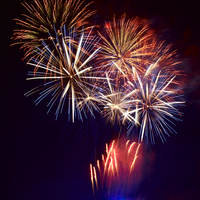Americans have celebrated Independence Day on July 4th with fireworks and speeches since 1777—but in some ways, the day is more of a symbol than an anniversary. Brush up on your history and learn a little more about your favorite summer holiday with these 4th of July fun facts!
We actually declared independence on July 2nd, 1776
The legal separation of the colonies from Great Britain happened two days earlier, when the Second Continental Congress voted to declare independence after King George III ignored the first Congress’ petition. The vote was unanimous, except for New York, which abstained. John Adams wrote to his wife Abigail that he expected this date to go down in history:
“The Second Day of July 1776, will be the most memorable Epocha, in the History of America. I am apt to believe that it will be celebrated, by succeeding Generations, as the great anniversary Festival.[…]It ought to be solemnized with Pomp and Parade, with Shews, Games, Sports, Guns, Bells, Bonfires and Illuminations from one End of this Continent to the other from this Time forward forever more.” (The Book of Abigail and John: Selected Letters of the Adams Family, 1762-1784, Harvard University Press, 1975, 142).
July 4, 1776 was the day the Declaration of Independence was approved by the Continental Congress
Very few of the members of Congress signed the Declaration of Independence on that date, and the vote to declare independence had taken place two days earlier. But because citizens learned about the vote from copies of the Declaration of Independence that were delivered and read aloud, they celebrated the date on that document: July 4th, 1776.
Most delegates didn’t sign the Declaration of Independence until August 2nd, 1776
John Hancock was famously the first to sign with letters much larger than other signatories’, but historical documents show that some of the men who signed the Declaration weren’t present in Congress on July 4th. They were present at a different meeting on August 2nd, and historians agree many of the signatures happened then.

The first public reading of the Declaration of Independence occurred on July 8th, 1776 in Philadelphia
Col. John Nixon read the Declaration aloud at the State House, and readings of the Declaration have taken place every Fourth of July since then. While bells throughout the city were rung to announce the reading, historians aren’t sure if the Liberty Bell, then called the State House Bell, was one of them.
[RELATED: Flag Day Fun Facts]
Many colonies and cities had already written declarations of independence that heavily influenced Jefferson’s draft
Fighting against British troops had begun well before 1776, but many still held out hope for a reconciliation. As fighting grew more heated, the colonies slowly recognized their desire for independence and began to create documents outlining their reasons and philosophies. The wording of these documents appeared frequently in Congress’ Declaration of Independence. One particularly influential document was the Virginia Declaration of Rights by George Mason.
Both Adams and Jefferson died on the 4th of July, 50 years later
Though the two stopped corresponding during Jefferson’s presidency, they were close lifelong friends, and they both passed away on Independence Day, 1826. Two other U.S. presidents had important claims on the date: James Monroe died on July 4, 1831, and Calvin Coolidge was born on July 4, 1872.
There is something written on the back of the Declaration of Independence
But it’s not a map! Upside down on the bottom of the reverse side, two lines appear:
“Original Declaration of Independence
dated 4th July 1776”
Current thought is that the document was rolled up and the label was added to the outside of the scroll. See it for yourself on the archives website.
The 4th of July commemorates many events and ideologies that led to the creation of our country. While you’re watching the fireworks this year, take pride in the long tradition of celebration you’re joining, and remember the stories behind the symbols.
Happy 4th of July!
Any topics you want to know more about? Let us know! The Varsity Tutors Blog editors love hearing your feedback and opinions. Feel free to email us at blog@varsitytutors.com.

